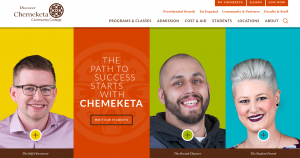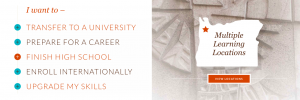6 Navigating The College Website
“Technology is a useful servant but a dangerous master.“
-Christian Lous Lange
A college website can be like a cookbook, full of great information and ideas, yet for many, it can be completely overwhelming. Where do you start? Looking at the pictures? Reading about the author? Can you taste the food in your mind just by looking at a picture? Can you imagine a food just from the list of ingredients? Is the number of ingredients needed to make the recipe exciting or paralyzing? How experienced a cook you are can impact your reaction to the cookbook.
As you begin navigating new information, remember, Julia Child wasn’t always a great chef! In fact, when she got married, she could barely cook. Experience doesn’t matter, an open mind does. Let the joy of discovering be your guide!
“Change can be frightening, and the temptation is often to resist it. But change almost always provides opportunities – to learn new things, to rethink tired processes, and to improve the way we work.”
-Klaus Schwab
The role of a college website has changed substantially over the past few years. Student expectations for easy, accessible information compels colleges to compress as much information online as possible. This situation can also lead to a battle for what information makes it onto the home page and how many clicks it will take to find what the student is looking for.
Student services are increasingly utilizing the college website to communicate with students and expect that students will be proficient in navigating the college website. Coinciding, students also expect to easily be able to locate the information they seek; this expectation can be met when the college uses logical organization to the information architecture and design of the website. Lamentably, some college websites can be very frustrating to new users, especially if the new user is a first-time college student and is unfamiliar with the underlying structure of the college system, after all, the people creating the college website are very familiar with the way the system works and may not see the structure as confusing.
Adding to the potential confusion, there can also be the lack of ability to view the entire home page of the college website depending on the size of monitor or mobile device in which the student is accessing the website from. Students today are increasingly using smartphones and tablets as their primary viewing device for the Internet, yet sometimes the key information a student needs may be just out of view on the screen. The experienced user knows to make adjustments, but new users may not. Knowing where and how to get started may not be as easy as the “start here” button.
The arrangement of information for the college’s needs may not be a logical progression of information for the students’ needs. From the college perspective, students come in different groups/classifications. Here are some examples:
- New

- Returning
- Transferring
- Students needing accommodations
- Local residents
- Veterans
- International
- Credit
- Non-credit/Community Education
- Adult Basic Education
Each of these groups can have variations on what their first steps should be and many times students aren’t necessarily used to thinking of themselves in terms of these classifications/groups. It can be difficult for first-time students, who may fit into more than one of these groups, to decide which group is the adequate place to start.
Most college websites offer a “Getting Started” type button on the home page. After clicking that button, a student begins to make a decision about what category of student he, she or they are. To an experienced user, this is not an obstacle, but to the first-time college student, it may be a barrier. Finding the information on the website can be challenging especially if the student is still undecided. The Chemeketa website has a block on the main website titled “I want to”. The website provides options. “Do you want to transfer to a university”, “prepare for a career?”, “finish high school?”, “enroll internationally?” or “upgrade my skills?”

In addition, some college websites may not be mobile friendly so that students who are trying to use smartphones or tablets may face additional obstacles. Nevertheless, despite the potential difficulties, today’s college students need to become savvy users of the college website and recognize the role it will play in the communication process. Therefore is always a good idea to navigate the website and get familiar with at least the search button.
Website challenge:
Pick 2 different colleges and examine their websites. Try to find the following information on each of the websites.
- Can you find the Mission Statement/Strategic Plan/Vision of the college?
- What does the statement say and why is it important to know a college’s mission/plan/vision?
- What are the steps you would to take to enroll at the college?
- How many locations does the college have and where are they?
- How long would it take you to travel to the location of that college?
- What term are you planning to attend the college for the first time? Is there an application deadline you must meet?
- Where can you find important dates and deadlines for the term?
- How long does a person need to live in Oregon to be considered a resident of the State in terms of college tuition at the colleges you are investigating?
- Does the college have a student conduct code? (A document about student rights and responsibilities)
- Does the college have placement tests a student needs to take prior to staring college?
- Does the website explain what type of tests are required and is there a cost?
- What are the test scores used for?
- Is financial aid available for students who attend the college?
- Does the website have student success stories and/or student success tips?
- Identify a program that you might like to study at the college.
Website Challenge Reflection
- How comfortable were you navigating the college websites?
- Did the websites’ organization make sense to you?
- What was your strategy for finding the information you were looking for?
- What information would you consider most important to you as a student?
- What suggestions do you have for making the website easier to use?
The college website will be part of your communication system with the college you attend. Your college website makes you part of a learning community.
- What other social media does the college use?
- As a student, how can you use the college website, social media, and the Internet in general to strengthen you learning community and connections?
John Green: Paper Towns and Why Learning is Awesome (TED Talks)
Video: https://youtu.be/NgDGlcxYrhQ
Licenses and Attributions
Original chapter work is attributed to Alise Lamoreaux. Chapter editing and additional work on the chapter is attributed to Grecia Garcia and Ashley Duran.

